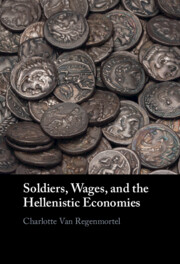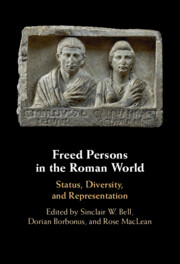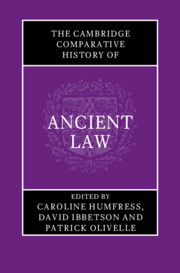Refine search
Actions for selected content:
23916 results in Ancient history

Soldiers, Wages, and the Hellenistic Economies
-
- Published online:
- 21 May 2024
- Print publication:
- 09 May 2024

Freed Persons in the Roman World
- Status, Diversity, and Representation
-
- Published online:
- 16 May 2024
- Print publication:
- 23 May 2024

The Cambridge Comparative History of Ancient Law
-
- Published online:
- 09 May 2024
- Print publication:
- 30 May 2024
Part I - In the Name of the Spirits
-
- Book:
- From Ritual to God in the Ancient Near East
- Published online:
- 03 May 2024
- Print publication:
- 09 May 2024, pp 21-78
-
- Chapter
- Export citation
Chapter 2 - The Concept of Wage Labour
-
- Book:
- Soldiers, Wages, and the Hellenistic Economies
- Published online:
- 21 May 2024
- Print publication:
- 09 May 2024, pp 31-49
-
- Chapter
- Export citation
Conventions
-
- Book:
- In Praise of Greek Athletes
- Published online:
- 02 May 2024
- Print publication:
- 09 May 2024, pp x-x
-
- Chapter
- Export citation
5 - One God in One Temple
- from Part III - A New Era
-
- Book:
- From Ritual to God in the Ancient Near East
- Published online:
- 03 May 2024
- Print publication:
- 09 May 2024, pp 165-203
-
- Chapter
- Export citation
Chapter 4 - Forms of Remuneration and Standards of Living
-
- Book:
- Soldiers, Wages, and the Hellenistic Economies
- Published online:
- 21 May 2024
- Print publication:
- 09 May 2024, pp 101-142
-
- Chapter
- Export citation
Acknowledgements
-
- Book:
- Soldiers, Wages, and the Hellenistic Economies
- Published online:
- 21 May 2024
- Print publication:
- 09 May 2024, pp x-xii
-
- Chapter
- Export citation
Epigraphic Dossier
-
- Book:
- Soldiers, Wages, and the Hellenistic Economies
- Published online:
- 21 May 2024
- Print publication:
- 09 May 2024, pp 197-216
-
- Chapter
- Export citation
Acknowledgments
-
- Book:
- From Ritual to God in the Ancient Near East
- Published online:
- 03 May 2024
- Print publication:
- 09 May 2024, pp xiii-xiv
-
- Chapter
- Export citation
Maps
-
- Book:
- Soldiers, Wages, and the Hellenistic Economies
- Published online:
- 21 May 2024
- Print publication:
- 09 May 2024, pp xxi-xxiv
-
- Chapter
- Export citation
Contents
-
- Book:
- In Praise of Greek Athletes
- Published online:
- 02 May 2024
- Print publication:
- 09 May 2024, pp vii-vii
-
- Chapter
- Export citation
Introduction
-
- Book:
- Soldiers, Wages, and the Hellenistic Economies
- Published online:
- 21 May 2024
- Print publication:
- 09 May 2024, pp 1-7
-
- Chapter
- Export citation
3 - Constructing Cosmotheism
- from Part II - For the Glory of the Gods
-
- Book:
- From Ritual to God in the Ancient Near East
- Published online:
- 03 May 2024
- Print publication:
- 09 May 2024, pp 81-120
-
- Chapter
- Export citation
Dedication
-
- Book:
- Soldiers, Wages, and the Hellenistic Economies
- Published online:
- 21 May 2024
- Print publication:
- 09 May 2024, pp v-vi
-
- Chapter
- Export citation
Contents
-
- Book:
- From Ritual to God in the Ancient Near East
- Published online:
- 03 May 2024
- Print publication:
- 09 May 2024, pp vii-viii
-
- Chapter
- Export citation
Chapter 6 - Military Wage Labour and the Hellenistic Economies
-
- Book:
- Soldiers, Wages, and the Hellenistic Economies
- Published online:
- 21 May 2024
- Print publication:
- 09 May 2024, pp 167-186
-
- Chapter
- Export citation
Chronology
-
- Book:
- Soldiers, Wages, and the Hellenistic Economies
- Published online:
- 21 May 2024
- Print publication:
- 09 May 2024, pp xiv-xvii
-
- Chapter
- Export citation
Chapter 1 - Contextualizing Paid Military Service
-
- Book:
- Soldiers, Wages, and the Hellenistic Economies
- Published online:
- 21 May 2024
- Print publication:
- 09 May 2024, pp 8-30
-
- Chapter
- Export citation
